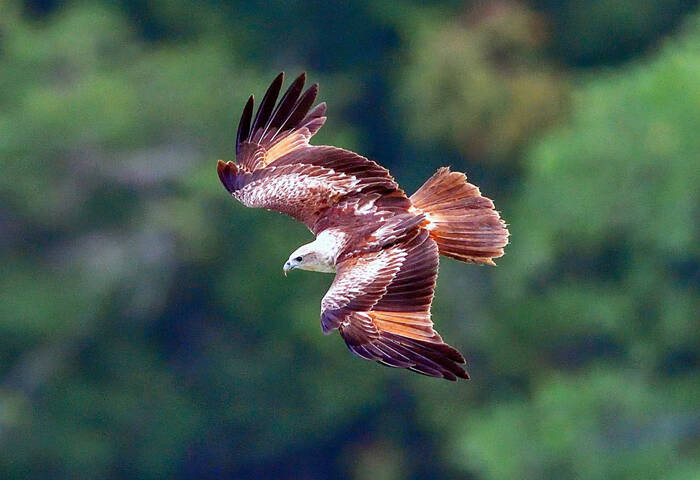Haliastur indus
IUCN
LCBasic Information
Scientific classification
- name:Haliastur indus
- Scientific Name:Haliastur indus,Brahminy Kite,Red Eagle, Red Eagle
- Outline:Raptor
- Family:Falconiformes Accipitridae Odontohawkinae Genus
Vital signs
- length:36-51cm
- Weight:700-1000g
- lifetime:10-30years
Feature
The head, neck, chest and upper back are white, and the rest of the body feathers and wings are chestnut
Distribution and Habitat
The chestnut kite is distributed in Southeast Asian countries such as India, Myanmar, Sri Lanka, India, Indonesia, New Guinea, the Philippines, and the northern, northwest and northeastern coastal areas of Australia, as well as Papua New Guinea and the Solomon Islands.
China only has the nominate subspecies, which is distributed in Inner Mongolia, Jiangsu, Zhejiang, Anhui, Fujian, Jiangxi, Shandong, Hubei, Guangdong, Guangxi, Yunnan, Tibet and other places. It is a migratory bird in Shandong, a summer migratory bird in Zhejiang and Guangxi, and a resident or migratory bird in Yunnan. The situation in other provinces and regions is unknown. Among them, Keshiketeng Banner, Inner Mongolia is a new record reported after the 1990s.
It mainly inhabits rivers, lakes, ponds, swamps, coastal coasts and nearby towns and villages. Except for breeding pairs and family groups, it usually moves alone. It is active during the day. It often soars and glides alone over lakesides, seashores, river
Appearance
The iris is brown or reddish brown, the bill is light blue-green or light lemon, with a blue base; the peak and tip of the bill are lighter, sometimes light yellow; the wax film is yellow, and the feet and toes are dark yellow, yellow-gray or yellow-green. The head, neck, chest and upper back are white, and the rest of the body feathers and wings are chestnut. The primary flight feathers are black, which is easy to distinguish from other birds of prey. When flying, the wings are tilted forward and slightly angled with the body. From above, the wings are chestnut, the tips of the wings are black, the head and neck are white, and the rest are chestnut. From below, the inside of the wings is chestnut, the tips of the wings are black, the flight feathers are light reddish brown, the head, neck and chest are white, and the rest of the body feathers are chestnut. Its tail feathers are round, different from the forked tail of the kite.
Adult birds: head, neck and chest are white, wings, ba
Details
Brahminy Kite is a medium-sized bird of prey with four subspecies in the world.

Brahminy Kite usually migrates in spring from March to April and leaves in autumn from October to November, but it is rare in all places.
The chestnut kite mainly feeds on crabs, frogs, fish, etc. It also eats insects, shrimps and reptiles, and occasionally small birds and rodents. It mainly relies on vision to find food, so its eyesight is particularly sharp. It usually lives in high and prominent places so that it can better observe the surroundings. When it finds prey on the ground, it suddenly swoops down from the air to catch it. It also catches prey such as small birds and large insects that fly past its eyes. Sometimes it also hovers over fishing villages or lives directly on the roofs of high houses. When fish or other animal entrails are thrown out, it flies to eat them, and sometimes it directly steals fish from fishermen. In addition to hunting on the ground, it also hunts in the water and in the air. The prey is either pecked directly on the ground or pecked while perched on a tree. Sometimes it also wanders around to find food or flies along the coast, pecking at carrion, dead fish and smelly meat along the way. In places where there are a lot of dead fish, it is also seen foraging in groups.
The breeding season of the chestnut kite is from April to July. Usually, the nest is built on a tall and isolated tree by the water, the edge of the farmland or in the fishing village, and occasionally on the roof of the house. The nest is rough. Usually, dead branches are piled on the trunk and fork of the tree. The shape is disc-shaped, with a concave middle, and soft hay, cotton, rags, hair and paper scraps are placed inside. The nest is shared by male and female birds. The male bird transports the nesting materials and food for the female bird, and the female bird builds the nest. Each nest lays 2-3 eggs, sometimes as many as 4 and as few as 1. The eggs are oval in shape, white or light blue in color, and some have a few fine brown or reddish brown spots or stripes. The female bird is mainly responsible for incubating the eggs, and the male bird hunts and transports food for the female bird. The incubation period is 26-27 days. The chicks are late-maturing. After hatching, they are fed by the parents together. They can fly and leave the nest after about 50-55 days.
Listed in the 2012 Red List of Endangered Species of the World Conservation Union (IUCN) ver3.1 - Least Concern (LC).
Listed as a Class II Key Protected Animal in China.
Listed as Class II Key Protected Wildlife in China.
Protect wild animals and stop eating game.
Maintaining ecological balance is everyone's responsibility!








